
|
Published: 22 September 2014
Queensland survey reveals lukewarm view of coal seam gas
Residents in Queensland’s Western Downs region have mixed feelings towards coal seam gas (CSG) development taking place in their midst, according to our CSIRO survey.

|
|
The study found that community dissatisfaction is connected with issues of road infrastructure, community participation in decision-making, and long-term environmental management. Credit: Jeremy Buckingham under CC BY 4.
|
More than two-thirds of locals described themselves as ‘tolerating’ or ‘accepting’ CSG, while only 22 per cent had openly positive attitudes. However, just 9 per cent of survey respondents rejected the industry outright.
Around half of the surveyed residents felt that their community was struggling to adapt to changes. Residents were also less optimistic about the future, with many predicting a decline in community wellbeing over the coming years.
Attitudes to coal seam gas
We conducted a representative survey of 400 people living in and around the towns of Chinchilla, Dalby, Miles and Tara, all of which are experiencing varying stages of CSG development. We asked people about their attitudes to CSG, as well as their opinions on the wellbeing and resilience of their communities in the face of both opportunities and challenges associated with rapid CSG development.
Opportunities include increased employment and business, new services and new facilities, and a more vibrant community, whereas the challenges include water and land management, traffic conditions and safety, and affordable housing.
There were mixed feelings towards CSG development in the region, with almost 70 per cent saying they either ‘tolerate’ or ‘accept’ it. A minority (22 per cent) ‘approve’ or ‘embrace’ it, while a smaller minority (9 per cent) of respondents ‘reject’ it.
Although these results indicate that attitudes to CSG are not strongly polarised in these communities, it is clear that some community members are strongly opposed to it.

|
|
Attitudes towards coal seam gas in Western Downs communities. Credit: CSIRO
|
In response to questions around how residents felt their community was dealing with CSG development in their region, about 50 per cent felt that their community was struggling to adapt to the changes – either ‘resisting’, ‘not coping’, or ‘only just coping’ with CSG development.

|
|
Perceptions of community responses to coal seam gas development in the area. Credit: CSIRO
|
Other results show that more positive attitudes to CSG are associated with community perceptions of being resilient, the environment being managed well for the future, good employment and business opportunities, and resource companies, government, and business working effectively with residents to deal with changes.
Differences across the region
Residents in Chinchilla see their community as adapting to changes more effectively than people in the other areas we surveyed. This reflects a perception that Chinchilla has better employment and business opportunities than places like Dalby and Tara, where respondents were more likely to find these opportunities unsatisfactory.
People who lived out of town reported lower levels of social interaction, services and facilities, employment and business opportunities, and overall community wellbeing than town residents. Although this may reflect general differences between rural and town life, those living out of town also had less favourable attitudes toward CSG (see the second chart above) and lower expectations of future community wellbeing .
Nevertheless, the overall average of community wellbeing across our whole survey was rated at 3.8 out of 5, which is robust and higher than many other Queensland regions when compared to similar items surveyed in a previous study.
Improving the situation
Our survey offers a snapshot of how people in Queensland’s Western Downs are feeling about the changes happening to their communities, and could form a basis for future strategies to support them.
The results suggest that investments made in wellbeing and resilience could lead to a more optimistic outlook for the future. In particular, three key areas that cause community dissatisfaction are road infrastructure, community participation in decision-making, and long-term environmental management.
However, we also found that while improving these things would benefit communities, these are not the most important factors for overall wellbeing. The things rated as most important are: services and facilities, community spirit and cohesion, a socially interactive community, personal safety, and environmental quality.
More optimistic outlooks for community wellbeing are associated with community resilience; especially good working relationships between groups, planning and leadership, supporting volunteers, and having access to information. Targeted investments are important but need to be combined with good collaboration between state and local governments, CSG companies, and local communities to enhance future community wellbeing.
Given that Queensland is more advanced than any other state in terms of CSG production, our study might also offer lessons for other regions of Australia that are facing the issue of CSG development, either now or in the future
Andrea Walton and Rod McCrea are social scientists, and Rosemary Leonard is a senior social scientist, with CSIRO. The Community Functioning and Wellbeing Project was funded by the Gas Industry Social and Environmental Research Alliance (GISERA), a collaborative vehicle undertaking independent research on the socio-economic and environmental impacts of Australia’s natural gas industries. This article was originally published on The Conversation.

